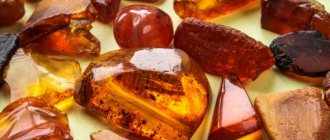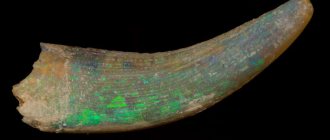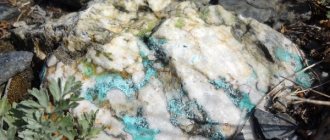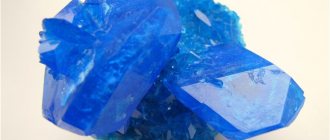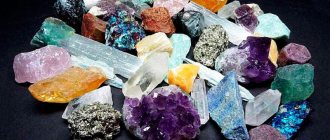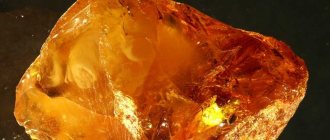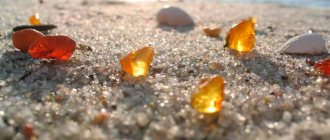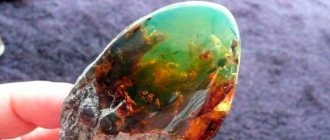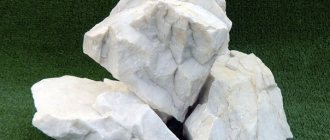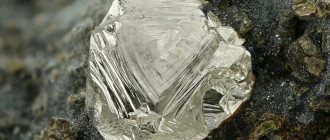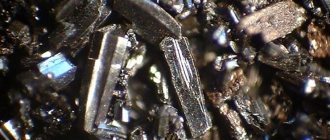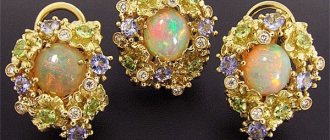In the dictionary D.N. Ushakova
DISGRACE, opals, female. 1. In pre-Petrine Russia - the anger, disfavor of the tsar towards the guilty boyar, as well as the punishment imposed on such a boyar (· source; · cf. scorch in 2 · meaning). Tsar's disgrace. The boyar is in disgrace. To put disgrace on someone. “Disgrace awaits us every day, prison, Siberia, hood or shackles.” Pushkin. “Great Voivode Vasily Vasilyevich Golitsyn sent out formidable decrees, threatening disgrace, ruin and batogs.” A.N. Tolstoy. 2. transfer Any disfavor, dislike towards a dependent person. “The disgrace of the authorities was also reflected in the private lessons of Lev Savvich.” Danilevsky. | In general, dislike, an unfriendly, negative attitude towards someone or something (more often joking). This man is in disgrace with his friends. “I have long since fallen out of love with reading, but he excluded several works from disgrace.” Pushkin.
Types and colors of opals
Various varieties of the mineral are found in nature. There are more than 130 of them in total. One of the most expensive, beautiful and rare is the magnificent milky opal with vague opalescence. Black specimens look no less beautiful. As a rule, they amaze with an extravaganza of glare in green, red, purple, blue, orange and other shades. The color of minerals depends on the type of chemical elements included in the composition.
Minerals are classified not only by color, but also by structure. This criterion allows us to identify more than 40 varieties. Only a few types are the most popular. For example:
- Fire opal is a yellow opal with a bizarre play of color. This group also includes samples of the closest shades: red, orange, wine yellow.
- Girazole is a colorless, almost transparent mineral. Some representatives of the species have a milky white or pale blue tint.
- Cacholong in appearance resembles shimmering pearls. This white opal captivates and enchants with its luxurious silvery-milky tints.
- Royal stones are those with truly amazing contrasting colors: red opals with a rich green border.
- Hydrophanes are opals whose appearance changes depending on the environment. If such stones fall into water, they become translucent and acquire an amazing shine.
- Harlequin opals have an amazing variegated surface. They combine all the colors of the rainbow.
- Hyalite stone, which is another type of opal, is completely transparent. Visually it is difficult to distinguish it from ordinary glass.
- Wax opal looks exactly like its name. The pebble has a waxy surface of a dim yellow hue.
Gold earrings with pearls and opals (go to the SUNLIGHT catalogue)
Minerals of milky, orange-red and blue shades are most often used in jewelry. The latter are called black because of the color saturation. A gem is assessed by its level of opalescence—the play of color.
Some people consider dendroopal to be a separate species. Such a stone really exists, but it is a type of agate. It is classified as opal by unscrupulous sellers and jewelers who want to increase the price of their products. Therefore, if you are offered to buy dendritic opal, be more careful.
Medicinal properties
Iridescent stones not only look attractive, but also have many healing properties. During that terrible period, when the plague swept through Europe, the European rich wore rings with opals, because they believed that the stone would protect them from infection.
Blue stone is able to protect the human psyche from overload. It takes away anxiety and excess energy from the owner. Gives peace and tranquility.
Opals are good for the heart in any form. Pinkish opal has the most beneficial effect on blood vessels and the heart. Wearing it on your chest stabilizes your heart rate and normalizes your blood pressure.
Green minerals are suitable for the eyes. Contemplation of a green stone relaxes the eye muscles and helps fight various eye ailments. Green-colored stones combat increased intracranial and ocular pressure.
Yellow minerals solve stomach problems. They also strengthen the immune system, making the body stronger, more resilient and faster. Yellow opals accelerate metabolic processes in the body and promote rejuvenation of the owner.
Review of a money amulet from Svetlana Basharova:
HOW DID I GET RICH THANKS TO A SIMPLE TRICK? Good afternoon dear friends! Today I want to share with you a very unusual story that recently happened to me. Two months ago I worked as an ordinary cashier in a hardware store. One day, a very nice woman was standing in line at my checkout. She bought some small items for the house. This woman was positively beaming in a wonderful mood. When the time came to pay, she handed me 5 thousand rubles and said: “Thank you, no change needed.” Her purchase amount was 809 rubles, which surprised me very much... Read more"
The fiery variety of stones is a real “elixir” of life for weakened and sick people. These stones are recommended for elderly and sick people to wear so that the body has the strength to cope with illness.
Opal deposits
Opals occur as thin layers or flat lenses; large specimens are rare.
This stone is very widespread, but most of its deposits (about 97%) are concentrated in Australia, where it is recognized as a national stone. — Advertising —
In addition to Australia, opals are mined in countries such as Ethiopia, Mexico, Brazil, Guatemala, Honduras, Japan, Czech Republic, USA, Russia, and Ukraine.
What will the king say?
These and other similar puns, brought to the attention of the emperor, completely angered him: Suvorov’s authority to command the troops was removed, he fell into disgrace, and was sent into exile in a remote village.
It seems that the great commander in L. Vashli’s painting “Suvorov in Disgrace” knows that his story is not over yet, and soon he will be called to serve his Motherland by the sounds of a military horn. So it will be.
Physical properties
Bringing good luck and almost extraterrestrial stone has such physical properties as:
- Hardness: up to 6 on the Moss scale;
- The mineral can be dissolved in alkali;
- Base: silicon dioxide;
- Gloss: pearlescent;
- Stones are prone to opalescence, a rainbow play of light.
Opal can be distinguished from chalcedony only by chemical analysis. The mineral can be transparent, or it can have any other color.
High transparency and rich shade are what distinguish precious stones from semi-precious opals with a transparent or milky color.
Blue stones, green minerals with emerald splashes, variations on the “cat's eye” theme and ink stones are considered the most expensive in the world. Opals with a red center and green inclusions, as well as fiery stones with a matrix structure, are of particular value on the jewelry market.
Polychromatic and gel silicas are difficult to distinguish from jasper or moonstone, but have unique properties that make them more valuable. In addition to natural opals, artificial stones similar in structure to natural silicas are grown in laboratories in different countries. A synthetic analogue of the mineral has greater hardness and increased fire resistance. This stone can have any color. Synthetic opal is cheaper than its natural counterpart.
Features of origin
Opal has a sedimentary supergene origin; it can be found both in the form of individual plates in the rocks of diatomite, tripoli and opok, and in the form of specific veins in these rocks. In the natural environment, opals are presented in the form of sinter nodules or nodules that cover other minerals. Often it is thanks to opals that fossils of plant and animal origin are formed.
The formation of these minerals occurs in the following way: in some arid area there is heavy rain, after which moisture enters the earthen rocks and fills the ground cracks. Over time, the moisture evaporates and layers, forming ordinary silica.
In addition to the natural explanation of the origin of this stone, there are dozens of myths and legends in the world associated with its appearance on Earth.
- Australian indigenous people believed that many years ago the Creator came to Earth to explain to people the meaning of rainbows, skies and clouds. When he stepped on Earth in his divine form, the pebbles and stones under his feet became shiny and colorful.
- According to Japanese legends, it is believed that at the moment of the creation of all things, the Creator blessed the Earth and placed a piece of the Sun in the rocks so that the soil would always remain warm and rich. From this particle modern opals were formed.
- The ancient Greeks believed that opals were the tears of Zeus himself, which he dropped after his victory over the Titans. Just touching the ground, his tears turned to stone and scattered across the globe.
- Indian legends tell of the great and beautiful goddess of the rainbow. Her beauty and divine light drove all the men crazy, who very soon decided to encroach on her innocence through brute force. Having fallen into a trap, the goddess threw herself off the cliff and scattered all over the world with thousands of solar and rainbow gems.
- Scandinavian myths tell of a blacksmith who created opals from the eyes of a small child to forever capture their natural beauty and charm. Since then, Scandinavians have believed that if you look long into the depths of blue and blue stones, you can probably see the face of a baby there.
In addition to legends about the mystical origin of the stone, a large number of other beliefs are associated with it. For example, in the Middle Ages, thieves loved to wear opals - they believed that the stone could make them invisible in moments of danger, and its lulling depth acted on victims like real hypnosis.
In one of the novels of the world famous Walter Scott, opal is described as an extremely dangerous and devilish stone, which fades with holy water and is used by sorcerers and witches for malicious conspiracies and curses. Since the novel received wide public recognition, many people stopped wearing this mineral. This continued until the 19th century - it was then that Queen Victoria began to actively use opals in the creation of jewelry and jewelry, and also often gave jewelry with this stone to her friends and members of the royal family.
Silent friends of the saints
“Elder Gerasim was great, so he had a lion. And we are small - we have a cat,” said Elder Nektary of Optina, stroking his mustachioed pet - an unusually smart and obedient cat.
The Christian tradition is characterized by love for animals. Her example was shown to us by many ascetics who labored in monasteries and hermitages from Asia Minor to the Far North. As Isaac the Syrian said:
“Animals smell the scent of heaven and go to the saints.”
Sergius of Radonezh, at the beginning of his monastic journey, was living alone in a deep forest when he saw a large bear near his hut. He acted like a stranger, offering the beast a piece of bread. The bear got used to the treat and often visited the hermit. The monk thanked God for sending him the fierce beast as a consolation. Sometimes he himself was left without food, giving the last piece of food to the furry guest. Sergius preferred not to eat that day and starve, rather than deceive the beast and let him go without food, says the life.
What will the king say?
These and other similar puns, brought to the attention of the emperor, completely angered him: Suvorov’s authority to command the troops was removed, he fell into disgrace, and was sent into exile in a remote village.
It seems that the great commander in L. Vashli’s painting “Suvorov in Disgrace” knows that his story is not over yet, and soon he will be called to serve his Motherland by the sounds of a military horn. So it will be.
Patron saints of animals
In Rus', from time immemorial, people have resorted to God, asking for mercy and protection for domestic animals. The custom has been preserved of sprinkling sick cattle with holy water, and in special cases even allowing them to drink it, driving the herd out to pasture with blessed willow, and even reading special prayers for health.
There are many saints whom the Orthodox Church considers to be the patrons of animals.
Among them is Saint Modest, who revived the poisoned cattle of one believer. Saint Blaise, who during his lifetime took care of many animals and birds that lived near his cell, and Saint Anthony did the same.
Saints Frol and Laurus are assistant horse breeders. Saint Nikita is the patron saint of waterfowl. And the pigs have a patron - Saint Basil. And Saint George even protects predators, in particular wolves.
They also pray to the Hieromartyr Athenogenes, Saint Agathia, Saint Anthony the Great, Saint Gerasimos of Jordan and many others.
Origin
Fragment of the jaw of the ancient mammal Kollikodon ritchiei
, which became opal during the fossilization process
Forms of release: cluster-shaped or kidney-shaped aggregates of amorphous silica, formation of cracks. It usually occurs among limonites, sandstones, rhyolites and basalts.
The origin is sedimentary, supergene or low-temperature hydrothermal. It occurs in the form of veins, filling cracks in the host rocks. The rocks diatomite, tripolite and opoka are made up of scattered small particles of opal. Opal forms various kinds of sintered forms or nodules, often forms pseudomorphs on various minerals, and also impregnates various animal and plant remains, forming fossils. Sometimes found in the form of earthy masses or fine powder.
